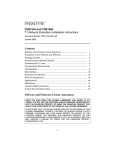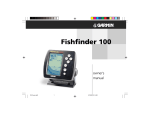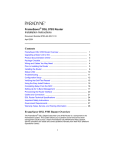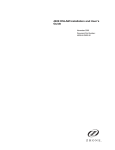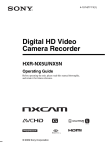Download Zhone ENE2084 Specifications
Transcript
ENE2044 and ENE2084 E1 Network Extenders Installation Instructions Document Number ENE2-A2-GN11-10 March 2005 Contents Software and Firmware License Agreement ................................................. 1 Introduction to the ENE2044 and ENE2084 ................................................. 3 Package Contents ......................................................................................... 4 Connecting the E1 Lines ............................................................................... 6 Connecting the Ethernet Lines ..................................................................... 7 LED Indicators .............................................................................................. 8 Web Interface ................................................................................................ 10 Establishing an ARP Table Entry for a Subscriber Unit ................................ 12 Command Line Interface ............................................................................... 13 Pin Assignments ........................................................................................... 15 Specifications ................................................................................................ 17 EMI Notices .................................................................................................. 18 Important Safety Instructions ........................................................................ 19 Product Documentation Online ..................................................................... 20 Software and Firmware License Agreement ONCE YOU HAVE READ THIS LICENSE AGREEMENT AND AGREE TO ITS TERMS, YOU MAY USE THE SOFTWARE AND/OR FIRMWARE INCORPORATED INTO THE PARADYNE PRODUCT. BY USING THE PARADYNE PRODUCT YOU SHOW YOUR ACCEPTANCE OF THE TERMS OF THIS LICENSE AGREEMENT. IN THE EVENT THAT YOU DO NOT AGREE WITH ANY OF THE TERMS OF THIS LICENSE AGREEMENT, PROMPTLY RETURN THE UNUSED PRODUCT IN ITS ORIGINAL PACKAGING AND YOUR SALES RECEIPT OR INVOICE TO THE LOCATION WHERE YOU OBTAINED THE PARADYNE PRODUCT OR THE LOCATION FROM WHICH IT WAS SHIPPED TO YOU, AS APPLICABLE, AND YOU WILL RECEIVE A REFUND OR CREDIT FOR THE PARADYNE PRODUCT PURCHASED BY YOU. 1 The terms and conditions of this License Agreement (the “Agreement”) will apply to the software and/or firmware (individually or collectively the “Software”) incorporated into the Paradyne product (the “Product”) purchased by you and any derivatives obtained from the Software, including any copy of either. If you have executed a separate written agreement covering the Software supplied to you under this purchase, such separate written agreement shall govern. Paradyne Corporation (“Paradyne”) grants to you, and you (“Licensee”) agree to accept a personal, non-transferable, non-exclusive, right (without the right to sublicense) to use the Software, solely as it is intended and solely as incorporated in the Product purchased from Paradyne or its authorized distributor or reseller under the following terms and conditions: 1. Ownership: The Software is the sole property of Paradyne and/or its licensors. The Licensee acquires no title, right or interest in the Software other than the license granted under this Agreement. 2. Licensee shall not use the Software in any country other than the country in which the Product was rightfully purchased except upon prior written notice to Paradyne and an agreement in writing to additional terms. 3. The Licensee shall not reverse engineer, decompile or disassemble the Software in whole or in part. 4. The Licensee shall not copy the Software except for a single archival copy. 5. Except for the Product warranty contained in the manual, the Software is provided “AS IS” and in its present state and condition and Paradyne makes no other warranty whatsoever with respect to the Product purchased by you. THIS AGREEMENT EXPRESSLY EXCLUDES ALL OTHER WARRANTIES, WHETHER EXPRESS OR IMPLIED, OR ORAL OR WRITTEN, INCLUDING WITHOUT LIMITATION: a. Any warranty that the Software is error-free, will operate uninterrupted in your operating environment, or is compatible with any equipment or software configurations; and b. ANY AND ALL IMPLIED WARRANTIES, INCLUDING WITHOUT LIMITATION IMPLIED WARRANTIES OF MERCHANTABILITY, FITNESS FOR A PARTICULAR PURPOSE AND NON-INFRINGEMENT. Some states or other jurisdictions do not allow the exclusion of implied warranties on limitations on how long an implied warranty lasts, so the above limitations may not apply to you. This warranty gives you specific legal rights, and you may also have other rights which vary from one state or jurisdiction to another. 6. IN NO EVENT WILL PARADYNE BE LIABLE TO LICENSEE FOR ANY CONSEQUENTIAL, INCIDENTAL, PUNITIVE OR SPECIAL DAMAGES, INCLUDING ANY LOST PROFITS OR LOST SAVINGS, LOSS OF BUSINESS INFORMATION OR BUSINESS INTERRUPTION OR OTHER PECUNIARY LOSS ARISING OUT OF THE USE OR INABILITY TO USE THE SOFTWARE, WHETHER BASED ON CONTRACT, TORT, WARRANTY OR OTHER LEGAL OR EQUITABLE GROUNDS, EVEN IF PARADYNE HAS BEEN ADVISED OF THE POSSIBILITY OF SUCH DAMAGES, OR FOR ANY CLAIM BY ANY THIRD PARTY. 2 7. The rights granted under this Agreement may not be assigned, sublicensed or otherwise transferred by the Licensee to any third party without the prior written consent of Paradyne. 8. This Agreement and the license granted under this Agreement shall be terminated in the event of breach by the Licensee of any provisions of this Agreement. 9. Upon such termination, the Licensee shall refrain from any further use of the Software and destroy the original and all copies of the Software in the possession of Licensee together with all documentation and related materials. 10. This Agreement shall be governed by the laws of the State of Florida, without regard to its provisions concerning conflicts of laws. Introduction to the ENE2044 and ENE2084 Paradyne's ENE2044 and ENE2084 are loop bonding network extenders for Paradyne's 12000 and 4000 IP Broadband Access Concentrators that provide up to 8 Mbps (ENE2044) or 16 Mbps (ENE2084) of symmetrical bandwidth using E1 lines. The ENE2044 features four E1 ports and the ENE2084 eight E1 ports, each capable of up to 2.0 Mbps bandwidth. When used with any Paradyne loop bonding compatible product, up to eight ports may be used to deliver high-speed bandwidth at any given distance. Paradyne's loop bonded technology provides automatic load balancing and fail-over for optimum redundancy and data throughput. In addition the ENE2044 and ENE2084 support repeaters installed on the E1 loop, ensuring maximum distance and flexibility. The ENE2044 and ENE2084 can be connected to any combination of E1 uplink interface modules, micro interface modules, and network extenders, so long as every connection pairs a provider and a subscriber unit. Provider and Subscriber Defaults The following table highlights the differences between provider and subscriber units. Table 1. Unit Defaults by Type Feature Provider Unit Subscriber Unit Default IP Address: 192.168.254.252 192.168.254.251 Out of Band Management: Over Ethernet Ports Over E1 Ports Inband Management: Over E1 Ports Over Ethernet Ports Response to Broadcast ARP Request by IP Address: Unit answers. Unit does not answer; answers only to ARP request specifying its MAC address. 3 Package Contents Unpack and Inspect the network extender. If there is any visible damage, do not attempt to connect the device. Contact your sales or service provider. Powering Up the Network Extender The DC power terminal block on the network extender has five terminals: two positive, two negative, and one ground. Only one positive terminal and one negative terminal pair need be connected for operational purposes. The second positive and negative terminal pair may be connected to a backup DC power supply for redundancy. The ground terminal must be connected regardlessly. DO NOT OPERATE THE NETWORK EXTENDER WITHOUT A GROUND CONNECTION. Procedure 1. Loosen all screws at the top of the power terminal strip. 2. Insert your ground wire in the center terminal and tighten the screw. 3. Insert your positive and negative leads into the left or right + and – pair of terminals, taking care to match polarity. Tighten the screws for those terminals. 10/100 Ethernet Con nections 1 2 3 48V .45A MAX 4 04-17607 4. Repeat Step 3 for the free pair of power terminals if you have a redundant power supply. 4 5. Verify that the Power LED on the front of the network extender is illuminated. Lnk/Act Duplex/Collision 1 2 3 4 Lnk/Alm 1 ENE2044 2 3 4 Tx 100 10/100 Ethernet Connections Rx COM E1 Connections Power 04-17604 Lnk/Act Duplex/Collision 1 2 3 4 Lnk/Alm ENE2084 2 3 4 5 6 7 8 Tx 100 10/100 Ethernet Connections 1 Rx COM E1 Connections Power 04-17603 5 Connecting the E1 Lines The primary feature of the network extender is loop bonding capability, although both the provider and subscriber units are able to function with a single E1 connection. Loop Bonded Connection Using multiple E1 lines for one network connection (loop bonding) multiplies the speed and data passing capability of the network extender. Multiple E1 lines also act as a backup should any of the lines become disabled. A network extender can only establish loop bonded connections with other Paradyne equipment with the loop bonding feature. See Product to Product E1 Loop Bonding Compatibility (document number COMP-A2-GK43). Procedure 1. Plug the E1 cables into the E1 Connections RJ45 ports on the back of the network extender. The order of connection is not important. 2. Verify all connections: the E1 Connections Lnk/Alm LEDs on the front of the network extender will pulse green to indicate the connections are established and operational. T1 or E1 Connections 10/100 Ethernet Con nections 1 2 3 4 1 2 3 48V .45A MAX 4 04-17602 1 T1 or E1 Connections 2 3 4 10/100 Ethernet Con nections 5 6 7 8 1 2 3 48V .45A MAX 4 04-17601 6 Single E1 Connection A single line connection can be established between a subscriber unit and any Paradyne E1 provider unit, regardless of loop bonding capability. Likewise, a single line connection can also be established between a provider unit and any of Paradyne's E1 subscriber units, regardless of loop bonding capability. Procedure 1. Plug the E1 cable into any of the E1 RJ45 ports on the back of the network extender. 2. Verify the connection: the related E1 Connections Lnk/Alm LED on the front of the network extender corresponding to the connected port will pulse green to indicate the connection is established and operational. Connecting the Ethernet Lines The 10/100BaseT Ethernet ports can auto-negotiate speed and duplex mode in accordance with the remote equipment to which it is connected, or Ethernet speed and duplex mode configurations can be configured using NMS. (See Web Interface on page 10.) For the best connection results, the remote devices (PCs, hubs, or switches) should be set to auto-negotiate speed and duplex mode. Procedure 1. Plug the Ethernet cable into one of the 10/100 Ethernet ports on the back of the network extender. A straight-through cable can be used for all applications. 2. Verify the connection: solid green illumination of the corresponding 10/100 Ethernet Connection Lnk/Act (Link/Activity) LED on the front of the network extender indicates a connection has been established. If the Ethernet Lnk/Act LED is illuminated but not the Ethernet 100 LED, then a 10 Mbps connection has been established. If the Ethernet Lnk/Act and 100 LEDs are both illuminated, then a 100 Mbps connection has been established. 7 LED Indicators Table 2. LEDs (1 of 2) LED State Indication Additional Information 10/100 Ethernet Connections Lnk/Act Pulsing Green Standard operation Traffic is flowing without any problems. Solid Green Ethernet connection is established If the Ethernet Lnk LED is illuminated but not the Ethernet 100 LED then a 10 Mbps connection has been established. If the Ethernet 100 LED is also illuminated, then a 100 Mbps connection has been established. Not Illuminated No Ethernet connection The Ethernet 100 and Act LEDs will remain unlit by default. Solid Amber Full duplex Ethernet connection. Not Illuminated No link, or functioning at half duplex. Pulsing Amber Half duplex link with packet collisions. Solid Green 100 Mbps Ethernet connection is established If the Ethernet 100 LED is illuminated, the Ethernet Lnk/Act LED will be green. Not Illuminated No 100 Mbps Ethernet connection If the Ethernet 100 LED remains unlit but the Ethernet Lnk/Act LED is green, then a connection has been established at 10 Mbps rather than 100 Mbps. 10/100 Ethernet Connections Duplex/ Collision 10/100 Ethernet Connections 100 8 Table 2. LEDs (2 of 2) LED State Indication Additional Information E1 Connections Lnk/Alm (Ports 1–4 or 1–8) Flashing Green* E1 connection is established and active Traffic is flowing. Solid Green E1 link A connection exists but there is indication of a problem with the E1 line. Solid Amber Remote Alarm Indication (RAI). The outgoing connection from the unit has been lost; no data is being transmitted. Yellow alarm. The unit's partner network extender has lost its incoming connection and has LOS. Pulsing Amber Alarm Indication Signal (AIS). An indirect connection has been lost; the unit may no longer be receiving data from its partner network extender. Blue alarm. The unit's partner network extender has lost a connection with an intermediate device and has LOS or RAI. E1 Connections Tx (Ports 1–4 or 1–8) Flashing Amber Data is being transmitted. Not Illuminated No data is being transmitted. E1 Connections Rx (Ports 1–4 or 1–8) Flashing Amber Data is being received. Not Illuminated No data is being received. Power Solid Green The unit is operational If the Power LED is not illuminated, it is unlikely that the network extender is receiving power and therefore none of the LEDs will be illuminated. * A pulsing LED blinks steadily at a rate of once per second. A flashing LED blinks at a more rapid, less constant rate. 9 Web Interface The network extender’s integral Network Management System (NMS) lets you configure and monitor the network extender using a standard web browser. To manage a Provider unit using NMS, connect your PC to any Ethernet port of the Provider unit. By default, the Subscriber unit can be managed by NMS through an active E1 line from the Provider side of the network. To enable inband management and configure an IP address, you must use the Command Line Interface. (See Command Line Interface on page 13.) After that is done, the Subscriber unit can be managed through its Ethernet ports. Web Interface System Requirements Web Browser – Required for running NMS. Compatible web browsers include, but are not limited to, Microsoft Internet Explorer (v4.0 or higher) and Netscape Navigator (v4.0 or higher). NMS is optimized for use with Internet Explorer. Use your browser's default settings when running NMS. JavaScript must be enabled. Screen Resolution – 1024 x 768 pixels is the minimum resolution required for all NMS views to fit within the dimensions of most monitors and laptops. Lower screen resolutions (such as 800 x 600 pixels) may cause NMS screens to exceed the width or height of the screen. To verify screen resolution on a Windows system: — Right click on your desktop — Select Properties — Click the Settings tab — Adjust the Screen Resolution as needed Configuring Your Windows PC to Communicate with NMS To communicate with NMS, your PC’s Ethernet interface must be on the same subnet as the network extender. For example, to configure the IP address under Windows XP: Procedure 1. In the Windows task bar, click on the Start button, and then click on Control Panel. 2. Double-click on the Network Connections icon. 3. In the LAN or High-Speed Internet window, right-click on the icon corresponding to your network interface card (NIC) and select Properties. (Often this icon is labeled Local Area Connection.) The Local Area Connection dialog box is displayed with a list of currently installed network items. 4. Ensure that the check box to the left of the item labeled Internet Protocol (TCP/IP) is checked, and click on Properties. 10 5. Write down the current IP Address and Subnet Mask in the Internet Protocol (TCP/IP) Properties dialog box. When you are done using NMS, you will need to reconfigure your PC with these values. 6. In the Internet Protocol (TCP/IP) Properties dialog box, click in the radio button labeled “Use the following IP address” and type 192.168.254.x (where x is any number between 3 and 250, inclusive) in the IP Address field. 7. Type 255.255.255.0 in the Subnet Mask field. 8. Click on OK twice to confirm your changes, and close the Control Panel. 9. Start your web browser. Type 192.168.254.252 (for a provider unit) or 192.168.254.251 (for a subscriber unit) into the Address field and press Enter. The web server opening screen appears. 10. Click on >> Next >>. The login dialog box appears. Log in using: Username: Password: superuser Password The NMS home page appears. 11 From this screen you can: Click on . . . To configure . . . Management Config. IP Address, Subnet Mask, Default Gateway, Inband Management VLAN ID and Priority Advanced Config. System Name and Location, Management IP Address Filter, TFTP and Telnet access HTTP Password General and Superuser Passwords SNMP Config. SNMP Notification IP Addresses and SNMP Traps SNMP Community SNMP Community Names Ethernet Connections Lnk/Act LEDs Ethernet Duplex Mode and Speed E1 Connections Lnk/Alm LEDs E1 Data Rate, Frame Type, Line Code, Tx Buildout, and Clock Source Establishing an ARP Table Entry for a Subscriber Unit Inband management is turned on by default in the subscriber unit, but the unit will not respond to an ARP request containing the unit’s default IP address. In order to manage the subscriber unit using NMS you must create a static ARP table entry on your PC. To build a static ARP table entry: Procedure 1. Get the MAC address from the bottom label of the subscriber unit. 2. Open a command prompt. (Click on Start, then Run. In the Open: window type CMD and press Enter.) At the command line, type: arp -s 192.168.254.251 xx-xx-xx-xx-xx-xx where the IP address is the default address of the subscriber unit and the MAC address is the number on the bottom label. Add 1 to the last byte of the MAC address if you are managing the unit from any of the Ethernet ports. For example: if the MAC address on the bottom label is 00-50-ca-01-28-86, use 00-50-ca-01-28-87 in the arp command. If the MAC address on the label is 00-50-ca-01-28-ea, use 00-50-ca-01-28-eb in the arp command. If you are managing the subscriber unit from the E1 side of the network, you do not have to add one to the MAC address since the WAN (E1) ports are considered to be Out of Band. Once the ARP table entry is configured, you can manage the unit using NMS. If you change the IP address to anything other than the default, the subscriber unit responds to ARP requests and does not require a static ARP table entry to manage it using NMS. 12 For security purposes you may want to turn off inband management of the unit to prevent a local PC from managing the unit from the Ethernet ports. Command Line Interface The network extender can be managed with a Command Line Interface (CLI) through either a direct PC to COM (Communication) Port connection or from a remote network connection via Telnet. CLI System Requirements Straight-Through RJ45 to RJ45 Ethernet Cable – Required for establishing a direct connection from the COM port to a DB9 adapter. DB9 Female to RJ45 Male Adapter – Required for conversion of your PC's RS232 serial port for use with the RJ45 to RJ45 Ethernet cable. Terminal Emulation Program – Required for running the CLI over a direct connection. The program must emulate a VT100 terminal. Telnet Client – Required for remote management with the CLI. Microsoft Windows Operating Systems (98, 2000, NT and XP) include a Telnet client which is run using the Windows command prompt (cmd.exe). If you are using an operating system other than Windows, you may need to install a Telnet client. Connecting a PC Directly Initial configuration using the CLI requires a direct physical connection from your PC to the COM port of the network extender you are configuring. (However, the web interface is recommended for subsequent configuration.) Procedure 1. Plug a DB9 to RJ45 adapter into the RS232 serial port on your PC. See DB9 to RJ45 Adapter Pinouts on page 16. 2. Connect one end of a straight-through RJ45 to RJ45 Ethernet cable into the adapter plugged into your PC, and the other end of the cable into the COM port on the face of the network extender. 13 Launching the Terminal Emulation Program Launch the terminal emulation program on your PC and configure the program settings. Actual configurations will depend upon the program being used, though settings should be modeled after the list below; most are standard defaults. Refer to your terminal emulation program’s user manual for further information. Baud: Data Bits: Flow Control: Parity: 9600 8 Software or XON/XOFF none Port: Stop Bits: Transmit Delay: Com 1 1 n/a Logging Into the CLI Once your terminal emulation program has been launched, device information is displayed, followed by a request for username and password. You must log in as a superuser in order to make configuration changes. Username: Password: superuser Password After you have logged in, enter a question mark (?) to list the available commands. Using the CLI to Establish Inband Management CLI Set commands are used to establish inband management. For example: set slot 1 ip_address 137.182.10.251 set slot 1 subnet_mask 255.255.255.0 set slot 1 default_gateway 137.182.10.10 The Subscriber unit in this example can now be managed with NMS by attaching a PC to one of the network extender’s Ethernet ports and opening the address 137.182.10.251 in a web browser. 14 Pin Assignments E1 RJ45 Pin Assignments If you are using a shielded E1 cable for your network connection, it must be grounded through pins 3, 6, 7 and 8. Table 3. E1 RJ45 Pin Assignments Pin Function Pin 1 Rx Ring Pin 2 Rx Tip Pin 3 not used Pin 4 Tx Ring Pin 5 Tx Tip Pin 6 not used Pin 7 not used Pin 8 not used Ethernet RJ45 Pin Assignments Table 4. Ethernet RJ45 Pin Assignments Pin Function Pin 1 Rx+ Pin 2 Rx– Pin 3 Tx+ Pin 4 not used Pin 5 not used Pin 6 Tx– Pin 7 not used Pin 8 not used 15 DB9 to RJ45 Adapter Pinouts To connect the COM port to the DB9 serial port of a PC, use an adapter wired as shown: Table 5. DB9 to RJ45 Adapter Pinouts Pin RJ45 Port Direction PC RS232 Serial Port 1 Transmit Data TxD → RxD Receive Data 2 2 Data Set Ready DSR ← RTS Request to Send 7 4 Receive Data RxD ← TxD Transmit Data 3 5 Ground GND ↔ GND Ground 5 6 Data Terminal Ready DTR → CTS Clear to Send 8 Pins not shown are unused. 16 Pin Specifications Specifications are subject to change without notice. Table 6. Specifications Specification Criteria Dimensions 1.25" (3.2 cm) High x 8.5" (21.6 cm) Wide x 4.75" (12.1 cm) Deep Weight 1.0 lbs (0.45 kg) Power –36 VDC to –72 VDC Optional AC to DC converter also available Interfaces ENE2044: 4 E1 RJ48C 8-position jacks (Unchannelized E1) ENE2084: 8 E1 RJ48C 8-position jacks (Unchannelized E1) 4 10/100 Ethernet RJ45 jacks Standards Supported IEEE 802.3 Ethernet IEEE 802.1p Priorities IEEE 802.1Q VLAN ITU G.704 E1 Protocols Supported Transparent 802.1D Bridging E1 Line Code: HDB3, AMI Bandwidth/Distance Up to 2.0 Mbps per E1 port ENE2044: Up to 8 Mbps using loop bonded E1 circuits ENE2084: Up to 16 Mbps using loop bonded E1 circuits Regulatory Compliance EMC: FCC Part 15; ICES-003; EN 300 386-2; CE Marking Operating Environment Temperature: 32°F to 122°F (0°C to 50°C) Safety: UL1950, CSA C22.2 No. 950; EN60950; IEC950; CE Marking Non-operating temperature: –40°F to 158°F (–40°C to 70°C) Humidity: 5% to 95%, non-condensing Altitude: –200 ft to 16,500 ft (–60 m to 5,000 m) 17 EMI Notices United States – EMI Notice: This equipment has been tested and found to comply with the limits for a Class A digital device, pursuant to Part 15 of the FCC rules. These limits are designed to provide reasonable protection against harmful interference when the equipment is operated in a commercial environment. This equipment generates, uses, and can radiate radio frequency energy and, if not installed and used in accordance with the instruction manual, may cause harmful interference to radio communications. Operation of this equipment in a residential area is likely to cause harmful interference in which case the user will be required to correct the interference at his own expense. The authority to operate this equipment is conditioned by the requirements that no modifications will be made to the equipment unless the changes or modifications are expressly approved by Paradyne Corporation. If the equipment includes a ferrite choke or chokes, they must be installed per the installation instructions. Canada – EMI Notice: This Class A digital apparatus meets all requirements of the Canadian interference-causing equipment regulations. Cet appareil numérique de la classe A respecte toutes les exigences du réglement sur le matérial brouilleur du Canada. 18 ! Important Safety Instructions 1. Read and follow all warning notices and instructions marked on the product or included in the manual. 2. Do not allow anything to rest on the power cord and do not locate the product where persons will walk on the power cord. 3. Do not attempt to service this product yourself, as opening or removing covers may expose you to hazardous voltage or to other risks. Refer all servicing to qualified service personnel. 4. General purpose cables are used with this product for connection to the network. Special cables, which may be required by the regulatory inspection authority for the installation site, are the responsibility of the customer. Use a UL Listed, CSA certified, minimum No. 26 AWG line cord for connection to the Digital Subscriber Line (DSL) network. 5. When installed, the product must comply with the applicable Safety Standards and regulatory requirements of the country in which it is installed. If necessary, consult with the appropriate regulatory agencies and inspection authorities to ensure compliance. 6. A rare phenomenon can create a voltage potential between the earth grounds of two or more buildings. If products installed in separate buildings are interconnected, the voltage potential may cause a hazardous condition. Consult a qualified electrical consultant to determine whether or not this phenomenon exists and, if necessary, implement corrective action prior to interconnecting the products. 7. Input power to this product must be provided by one of the following: (1) a UL Listed/CSA certified power source with a Class 2 or Limited Power Source (LPS) output for use in North America, or (2) a certified Class II power source, with a Safety Extra Low Voltage (SELV) output having a maximum of 240 VA available, for use in the country of installation. 8. In addition, since the equipment is to be used with telecommunications circuits, take the following precautions: — Never install telephone wiring during a lightning storm. — Never install telephone jacks in wet locations unless the jack is specifically designed for wet locations. — Never touch uninsulated telephone wires or terminals unless the telephone line has been disconnected at the network interface. — Use caution when installing or modifying telephone lines. — Avoid using a telephone (other than a cordless type) during an electrical storm. There may be a remote risk of electric shock from lightning. — Do not use the telephone to report a gas leak in the vicinity of the leak. 19 Product Documentation Online Complete documentation for Paradyne products is available at www.paradyne.com. Select Support → Technical Manuals. To order a paper copy of a Paradyne document, or to speak with a sales representative, please call 1-727-530-2000. *ENE2-A2-GN11-10* *ENE2-A2-GN11-10* Copyright 2005 Paradyne Corporation. Printed in U.S.A. 20




















